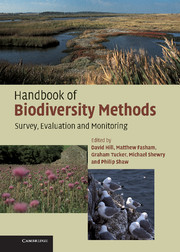Book contents
- Frontmatter
- Contents
- Preface
- Acknowledgements
- Part I Planning
- 1 Introduction to planning
- 2 Planning a programme
- 3 Biodiversity evaluation methods
- Part II Habitats
- Part III Species
- Appendix 1 Monitoring and reporting obligations under international conservation agreements
- Appendix 2 Relationship between BAP Priority Habitat and Broad Habitat categories and Habitats Directive nomenclature
- Appendix 3 Annotated list of key references for plant identification
- Appendix 4 Determining appropriate quadrat size for vegetation sampling
- Appendix 5 The relocation of permanent plots
- Appendix 6 Equipment required for undertaking different types of survey
- Recommended sources of further information
- References
- Glossary
- Index
2 - Planning a programme
Published online by Cambridge University Press: 01 September 2010
- Frontmatter
- Contents
- Preface
- Acknowledgements
- Part I Planning
- 1 Introduction to planning
- 2 Planning a programme
- 3 Biodiversity evaluation methods
- Part II Habitats
- Part III Species
- Appendix 1 Monitoring and reporting obligations under international conservation agreements
- Appendix 2 Relationship between BAP Priority Habitat and Broad Habitat categories and Habitats Directive nomenclature
- Appendix 3 Annotated list of key references for plant identification
- Appendix 4 Determining appropriate quadrat size for vegetation sampling
- Appendix 5 The relocation of permanent plots
- Appendix 6 Equipment required for undertaking different types of survey
- Recommended sources of further information
- References
- Glossary
- Index
Summary
The major steps involved in planning and executing a monitoring programme are illustrated in Figure 2.1. Many of the aspects are relevant to planning and executing a survey. A list of key considerations that must be addressed when planning a monitoring programme is given in Box 2.1 with the relevant section numbers. All of these issues should be carefully considered in a step-by-step process before any fieldwork is started.
SETTING THE OBJECTIVES FOR THE MONITORING PROGRAMME
Clearly and explicitly defining your objectives is probably the most important single step of any monitoring programme. Failure to do somay render any results gained inappropriate to the question you wished to address, and therefore useless. Carefully defining your objectives will also allow you to select the most appropriate methodology. In particular it is essential that you ask yourself: What do I really need to know? The process of defining objectives underpins good sitemanagement principles and the development of management plans (see, for example, CCW, 1996) of which monitoring should be an integral part (Figure 1.1). Guidance on establishing clearly defined objectives is provided below.
What features of conservation interest are to be monitored?
The first step in defining the objectives of any ecological monitoring programme must be the identification of features of interest on the site. Biological features may be habitats, species or species assemblages.
- Type
- Chapter
- Information
- Handbook of Biodiversity MethodsSurvey, Evaluation and Monitoring, pp. 6 - 64Publisher: Cambridge University PressPrint publication year: 2005
- 3
- Cited by



